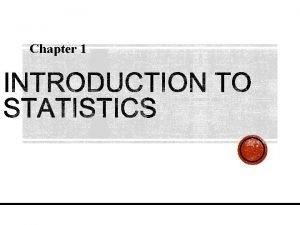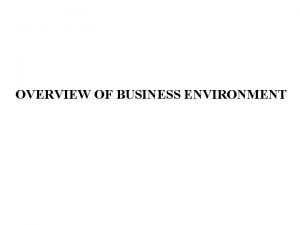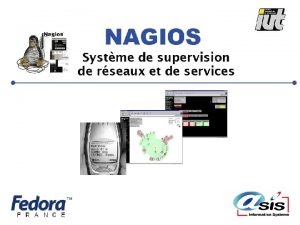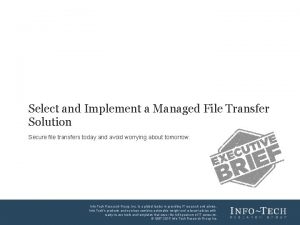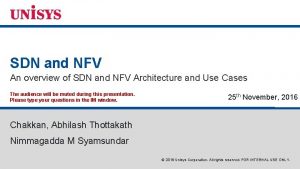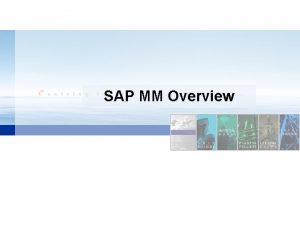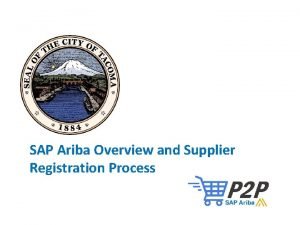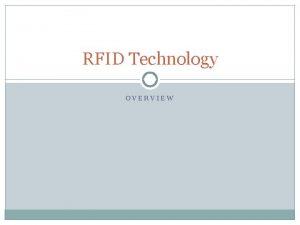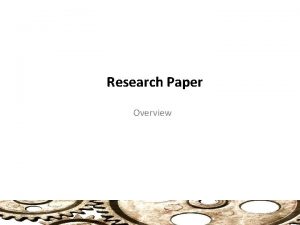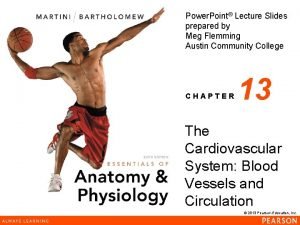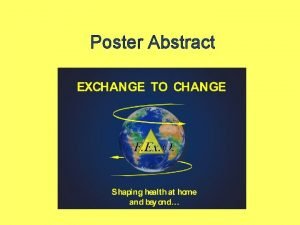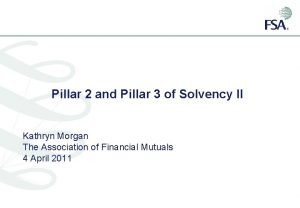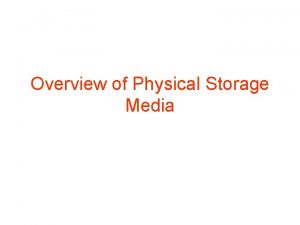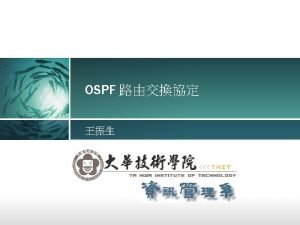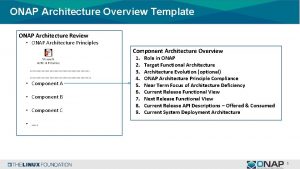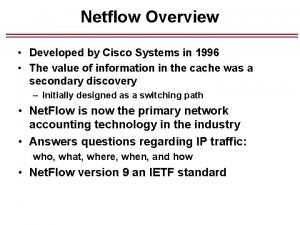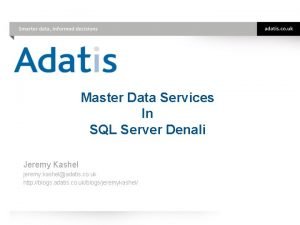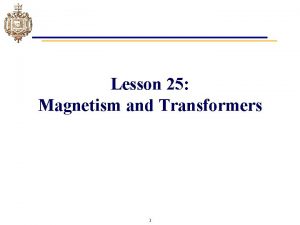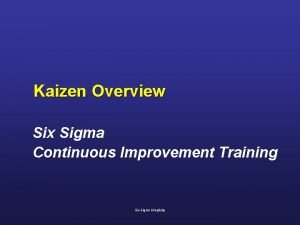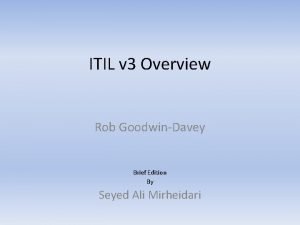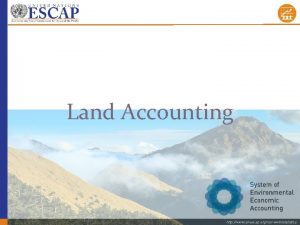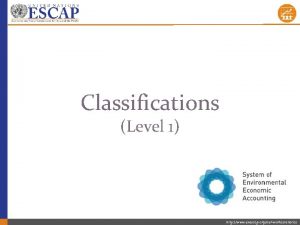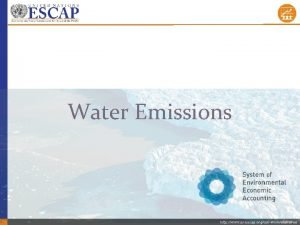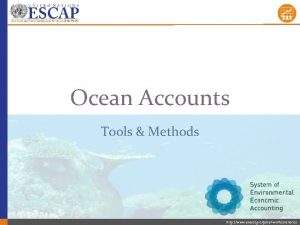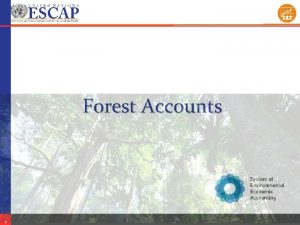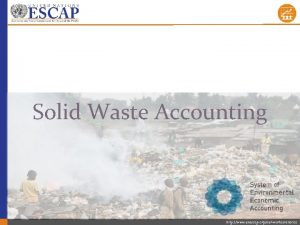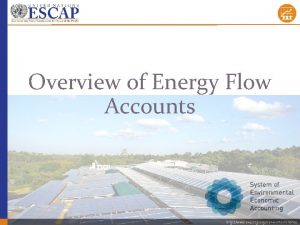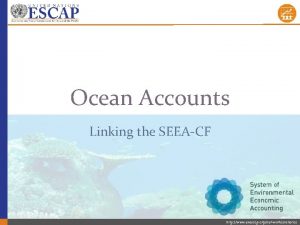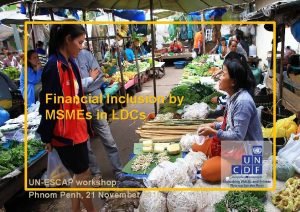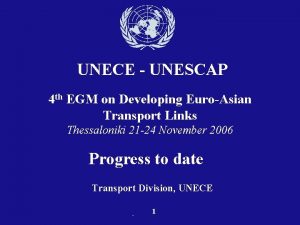Overview of Environment Statistics http www unescap orgourworkstatistics




















































- Slides: 52

Overview of Environment Statistics http: //www. unescap. org/our-work/statistics

Highlights of Presentation • Decisions are becoming more integrated: • SDGs, green economy, climate, biodiversity, nexuses • Need integrated, ongoing, reliable information • Environment statistics are produced by many agencies • Fragmented and require standardization • Official statisticians have tools and capacity to standardize and integrate environment statistics • FDES guidance on collecting environment data • SEEA for integrating environmental with economic data 2 ESCAP - Environment Statistics Overview http: //www. unescap. org/our-work/statistics

Observation on accounting: If we managed our economy the way we manage our environment, we’d still be hunter-gatherers. - Michael Bordt, 2015 3 ESCAP - Environment Statistics Overview Account for Natural Capital http: //www. unescap. org/our-work/statistics

What’s the problem? • Decisions are becoming more integrated: • Sustainable development; green economy; climate change; biodiversity • Develop or conserve? Where to develop? • Short/Long-term benefits? Who benefits? • Environment statistics are produced by many agencies • Therefore fragmented and require standardization • NSOs have focussed on economic and social statistics • May not have people or institutional arrangements to produce environment statistics 4 ESCAP - Environment Statistics Overview http: //www. unescap. org/our-work/statistics

Decisions are integrated (example) • People need water, food and energy, while • limiting climate change • Viable energy options may reduce equitable access to water and food while adding to un. Bearable climate change • Local optimization doesn’t work any more! 5 ESCAP - Environment Statistics Overview New statistical tools enable us to quantify these linkages and understand the trade-offs. http: //www. unescap. org/our-work/statistics

Why National Statistical Offices (NSOs)? • “Fundamental principles of official statistics” foster: • Culture of quality, impartiality, confidentiality, relevance • Trust by government, business and civil society • Tools and expertise to work with complex data • Confidential data collection processes (surveys, accounts, administrative data) can be adapted for environment statistics • Often custodians of the National Statistical System & SDG monitoring and reporting 6 ESCAP - Environment Statistics Overview http: //www. unescap. org/our-work/statistics

Environment statistics are interdisciplinary and inter-institutional Environment statistics are about: � the state of the environment, � our dependence on it, � our impact on it, � it’s impact on us (even negative ones), and � how we protect and manage it. This information comes from many institutions using different methods, concepts and classifications. FDES: Framework for the Development of Environment Statistics 7 ESCAP - Environment Statistics Overview http: //www. unescap. org/our-work/statistics

Information, data, statistics, accounts Metadata and indicators The world Information Rules: Data: Qualitative Quantitative Structure, Aggregate Themes: Stock/flow Statistics Accounts Select Indicators Combine Indices 8 ESCAP - Environment Statistics Overview http: //www. unescap. org/our-work/statistics

Three solitudes… What do you have? What do you want? Official Statistics What do you need to know? 9 ESCAP - Environment Statistics Overview Policy Science Time frame? Advocacy? Process orientation? Standards? Consistency over time? Coherence? Infrastructure? Complexity? Data management? http: //www. unescap. org/our-work/statistics

…or convergence? How can we solve problems? How can we help? Official Statistics You should know this! 10 ESCAP - Environment Statistics Overview Policy Science Collaboration Common objectives Understand strengths Develop capacity Develop infrastructure Identify gaps Ongoing statistics http: //www. unescap. org/our-work/statistics

Statistical tools for integration National Planning High quality indicators SEEA: System of Environmental-Economic Accounting Standards for measuring interactions between environment and economy SNA: System of National Accounts Standards for measuring the economy FDES: Framework for the Development of Environmental Statistics Basic statistics GSBPM: Generic Statistical Business Process Model Integrated statistical processes DQAF: Data Quality Assessment Framework Quality guidelines NSDS: National Strategies for the Development of Statistics Diagnostic Tool, Inventory Template Strategic planning and assessment 11 ESCAP - Environment Statistics Overview Integrated accounts Harmonized data (standards & processes) Fragmented environmental, economic and social da http: //www. unescap. org/our-work/statistics

FDES Structure FDES describes the scope and components of environment statistics; harmonizes data with common standards SEEA integrates these data into “accounts” 12 ESCAP - Environment Statistics Overview http: //www. unescap. org/our-work/statistics

SEEA in the SNA • SNA 2008 p. 534 • 29. 104 As with the SNA, the SEEA accounts provide • a scorekeeping function from which key indicators can be derived and • a management function in that they can be used in the analysis of policy options. 13 ESCAP - Environment Statistics Overview http: //www. unescap. org/our-work/statistics

Another observation on accounting Indicators Accounts Economic Data Economic statistics: • Macro-economic theory • Trusted framework (SNA) • Accepted indicators (GDP…) • Statistical infrastructure 14 ESCAP - Environment Statistics Overview Environment statistics: � Many theories � Collected for specific purposes � Few accepted indicators � Little statistical infrastructure http: //www. unescap. org/our-work/statistics

SEEA is • A coherent measurement framework linked to SNA: • Aligns concepts, classifications and methods • Based on accounting principles & systems theory • Flexible and modular • Select and adapt components to country needs • Don’t need to be complete to be useful • Since 1992, has been implemented, in part, by over 90 countries • Is NOT: a model, database or analytical framework 15 ESCAP - Environment Statistics Overview http: //www. unescap. org/our-work/statistics

SEEA does • Provide guidance on producing “accounts” for: • Natural inputs to the economy, • Impacts of the economy on the environment, and • Expenditures to mitigate impacts • Support sustainable statistical infrastructure to regularly produce relevant accounts and indicators • Improve coherence by standardizing concepts, classifications and methods • Reduce overlaps in data collection • “collect once, use many times” • Improve relevance by linking to SNA 16 ESCAP - Environment Statistics Overview http: //www. unescap. org/our-work/statistics

International platforms for integration OECD Green Growth World Bank WAVES CBD Aichi Targets UNEP TEEB, Green Economy, SCP Agenda 21, Rio +20, SDGs: Integrate nature into decision making!!! UNEP, FAO, UNDP: REDD+ 17 ESCAP - Environment Statistics Overview IPBES, IPCC UNDP Biofin http: //www. unescap. org/our-work/statistics

Stocks & flows in the SEEAs Environment Stocks Minerals & energy Timber Aquatic Other biological Materials Benefits/Costs Water Energy Ecosystems + conditions Water Ecosystem services Solid waste Air emissions Mitigate & Manage Ecosystem impacts 18 SEEA - Physical flows Economy Production Consumption Accumulation Imports Exports Effluents • National Balance Sheet • Resource life Flows Minerals & energy Residuals National wealth Protection $ Goods & Services Taxes & subsidies • SNA: Contribution of natural inputs to economy (rent) • Depletion, degradation adjusted net savings • Non-SNA: Contribution of natural inputs to well being • Expenditures on protection, management • Externalities? http: //www. unescap. org/our-work/statistics

Environment accounts and statistics SEEA-CF (Central Framework) • Assets • Physical flows • Monetary flows • Minerals & Energy, Land, Timber, Soil, Water, Aquatic, Other Biological • Materials, Energy, Water, Emissions, Effluents, Wastes • Protection expenditures, taxes & subsidies SEEA Water; SEEA Energy; SEEA Agriculture, Forestry and Fisheries Add sector detail As above for • Water • Energy • Agricultural, Forestry and Fisheries SEEA-EEA (Experimental Ecosystem Accounting) Adds spatial detail and ecosystem perspective Extent, Condition, Ecosystem Services, Carbon, Water, Biodiversity FDES (Framework for the Development of Environment Statistics) Basic statistics for above plus… • Extreme events and disasters • Human settlements and health • Protection, management & engagement 19 ESCAP - Environment Statistics Overview http: //www. unescap. org/our-work/statistics

Where to start? Priority concerns (from ADB Myanmar Environmental Performance Review 2012) Related accounts and statistics Related SDGs 1. Forest degradation 3. Land degradation Land Asset Account Ecosystem Account (Extent) 15 Life on Land 2. Water resources and quality Water Account (Asset; Supply /Use) 6 Water Ecosystem Account (Water) 14 Life on Water 4. Climate change Energy Account Air Emissions Ecosystem Account (Carbon) 7 Energy 13 Climate 5. Solid waste management Solid Waste Account 11 Urban 12 Consumption 6. Biodiversity loss Ecosystem Account (Biodiversity) 14 Oceans 15 Life on Land 7. Impacts of mining on the environment Land Asset Account Ecosystem Account (Condition) 15 Life on Land 20 ESCAP - Environment Statistics Overview http: //www. unescap. org/our-work/statistics

Asia and the Pacific SEEA Progress (preliminary) Number of accounts (max = 33) 0 Australia Afghanistan Australia (Victoria) Bangladesh Bhutan Cambodia China Cook Islands Federated States of Micronesia Fiji Hong Kong India Indonesia Iran Japan Kiribati Republic of Korea Kyrgyzstan Lao PDR Malaysia Maldives Marshall Islands Mongolia Myanmar Nepal New Zealand Palau Papua New Guinea Philippines Russia Samoa Timor-Leste Thailand Vanuatu Vietnam 21 ESCAP - Environment Statistics Overview 2 4 6 8 10 12 14 16 Ongoing Planned http: //www. unescap. org/our-work/statistics

The details 22 ESCAP - Environment Statistics Overview http: //www. unescap. org/our-work/statistics

Balancing nature’s books • Stock/flow Assets, Supply/Use • Asset Accounts: Opening balances, additions, removals, closing balance • Supply/Use Accounts: Supplier User • Double/quadruple entry • Monetary and physical transaction between supplier and user • Time of recording: When transaction occurred • Consistent units of measure, concepts, classifications, methods & valuation rules 23 ESCAP - Environment Statistics Overview http: //www. unescap. org/our-work/statistics

What is an “account”? One common theme: Common unit of measure Convert ($/month, litres/day, m 3/month) Different data sources: Household survey: 100 Municipal admin: 300 Industry survey: 175 All users/uses Water use account (m 3/year) Rows add up Columns add up 24 ESCAP - Environment Statistics Overview Total http: //www. unescap. org/our-work/statistics

The SEEA and the SNA • The SNA measures national economic activity, production and assets (wealth): • In monetary terms • By tracking transactions between economic units (businesses, households, governments) • The SEEA measures environment/economy links: • Expands asset boundary (includes physical natural assets) • Distinguishes expenditures on environmental protection • Records physical quantities of natural inputs to the economy • Records residuals produced and consumed (and by whom) • Records changes in private and public natural assets 25 ESCAP - Environment Statistics Overview http: //www. unescap. org/our-work/statistics

SNA view of the world Sectors Industries 1 Industrial output of goods and services Industrial intermediate demand Assets Financial and produced assets, opening balance 4 Gross fixed capital formation 5 Other changes in volume & holding gains/losses on financial & produced assets 6 3 Final demand 2 Sectors Residuals Products Final demand Financial and produced assets, closing balance 26 ESCAP - Environment Statistics Overview 7 http: //www. unescap. org/our-work/statistics

SEEA view of the world Final demand Sectors Industries Private 1 Public Assets Financial and produced assets, opening balance Natural resource assets, opening balance Industrial intermediate demand Final demand Gross fixed capital formation Environmental protection expenditures Capital expenditures for environmental protection Resource production by industries Resource production by households/gov’t Resource use by industries Resource use by households/gov’t Waste consumption by industries Waste consumption by households/gov’t Waste output by industries Waste output by households/gov’t Sectors Residuals Products Industrial output of goods and services 27 ESCAP - Environment Statistics Overview 2 3 4 5 Other changes in volume & holding gains/losses on financial & produced assets Changes in and holding gains/losses on natural resource assets Changes in natural resource assets Financial and produced assets, closing balance Natural resource assets, closing balance http: //www. unescap. org/our-work/statistics

One environment: Two perspectives Individual environmental assets & resources: Timber Water Soil Fish SEEA Central Framework starts with economy and brings in information on natural assets, flows and residuals 28 ESCAP - Environment Statistics Overview Ecosystems: Biotic and abiotic elements functioning together: Forests Lakes Cropland Wetlands SEEA Experimental Ecosystem Accounting starts with ecosystems and links their services to economic and other human activity Together, they provide the foundation for measuring the relationship between the environment, and economic and other human activity http: //www. unescap. org/our-work/statistics

Environment accounts and statistics SEEA-CF (Central Framework) • Assets • Physical flows • Monetary flows • Minerals & Energy, Land, Timber, Soil, Water, Aquatic, Other Biological • Materials, Energy, Water, Emissions, Effluents, Wastes • Protection expenditures, taxes & subsidies Add sector detail SEEA Water; SEEA Energy; SEEA Agriculture, Forestry and Fisheries As above for • Water • Energy • Agricultural, Forestry and Fisheries SEEA-EEA (Experimental Ecosystem Accounting) Adds spatial detail and ecosystem perspective Extent, Condition, Ecosystem Services, Carbon, Water, Biodiversity FDES (Framework for the Development of Environment Statistics) Basic statistics for above plus… • Extreme events and disasters • Human settlements and health • Protection, management & engagement 29 ESCAP - Environment Statistics Overview http: //www. unescap. org/our-work/statistics

SEEA-CF – The Accounts • Assets (=stocks; physical and monetary): • • Mineral and energy resources Land, Forest Soil Timber Aquatic resources Other biological resources Water 30 ESCAP - Environment Statistics Overview http: //www. unescap. org/our-work/statistics

SEEA-CF – The Accounts • Physical flows • Supply/use for materials (extract consume) • Material flows (through economy) to final demand (e. g. , GHGs) • Water supply/use • Energy supply/use • Residuals • Air emissions • Water emissions • Wastes (generated and used/recycled) 31 ESCAP - Environment Statistics Overview http: //www. unescap. org/our-work/statistics

SEEA-CF – The Accounts • Monetary flows • Environmental protection expenditures (demand side) • Environmental goods and services sector (supply side) • Resource use and management • Environmentally-related payments by & to government (fines, fees, taxes, subsidies, concession payments) 32 ESCAP - Environment Statistics Overview http: //www. unescap. org/our-work/statistics

Environment accounts and statistics SEEA-CF (Central Framework) • Assets • Physical flows • Monetary flows • Minerals & Energy, Land, Timber, Soil, Water, Aquatic, Other Biological • Materials, Energy, Water, Emissions, Effluents, Wastes • Protection expenditures, taxes & subsidies Add sector detail SEEA Water; SEEA Energy; SEEA Agriculture, Forestry and Fisheries As above for • Water • Energy • Agricultural, Forestry and Fisheries SEEA-EEA (Experimental Ecosystem Accounting) Adds spatial detail and ecosystem perspective Extent, Condition, Ecosystem Services, Carbon, Water, Biodiversity FDES (Framework for the Development of Environment Statistics) Basic statistics for above plus… • Extreme events and disasters • Human settlements and health • Protection, management & engagement 33 ESCAP - Environment Statistics Overview http: //www. unescap. org/our-work/statistics

SEEA-EEA (Ecosystem Accounting) • SDG Target 15. 9: By 2020, integrate ecosystem and biodiversity values into national and local planning, development processes, poverty reduction strategies and accounts • “Experimental” = in progress • Spatial framework of ecosystem units (30 -100 m) • Extent of ecosystem types • Condition of ecosystem asset • Classification and valuation of ecosystem services • Links to SEEA-CF and SNA • Tested in Australia, Canada, Mauritius, Netherlands, Philippines, pilot countries (Bhutan, Chile, Indonesia, Mexico, South Africa, Vietnam) 34 ESCAP - Environment Statistics Overview http: //www. unescap. org/our-work/statistics

SEEA-EEA Overview 35 ESCAP - Environment Statistics Overview http: //www. unescap. org/our-work/statistics

SEEA-EEA Accounts and tools Extent account • Ecosystem type + ownership and use • Changes over time General agreement on what exists on surface of country Land cover change (where, why? ) 36 ESCAP - Environment Statistics Overview http: //www. unescap. org/our-work/statistics

SEEA-EEA Accounts and tools Condition account • “Quality” and biophysical measures important to Ecosystem Services (ES) Overall condition, changes, location of changes Future flows of ES 37 ESCAP - Environment Statistics Overview http: //www. unescap. org/our-work/statistics

SEEA-EEA Accounts and tools Thematic accounts • Land (spatial detail) • Water (spatial detail, quality, ecosystems as beneficiaries) • Biodiversity (species ranges, characteristics, populations) • Carbon (focus on biocarbon) Contribute to Condition Accounts Focus on specific issues 38 ESCAP - Environment Statistics Overview http: //www. unescap. org/our-work/statistics

SEEA-EEA Accounts and tools Ecosystem Services supply / use accounts • Physical measures • Use by beneficiaries • Valuation to estimate monetary values Contribute to monetary Asset Account & links to SNA 39 ESCAP - Environment Statistics Overview http: //www. unescap. org/our-work/statistics

SEEA-EEA Accounts and tools Monetary asset accounts • Net Present Value of future flow of services Trade-offs Contribute to Balance Sheets 40 ESCAP - Environment Statistics Overview http: //www. unescap. org/our-work/statistics

SEEA-EEA Accounts and tools Links to SNA • Ecosystem Services in economic production functions • Degradation and depletion-adjusted aggregates (e. g. , value added minus depreciation) Trade-offs 41 ESCAP - Environment Statistics Overview http: //www. unescap. org/our-work/statistics

SEEA-EEA Accounts and tools Tools • Classifications (land cover, use, ecosystem services) • Methods (Spatial units, scaling & aggregation) • Biophysical modelling (future flows & filling gaps) 42 ESCAP - Environment Statistics Overview http: //www. unescap. org/our-work/statistics

Stages of implementing environment stats 1. Strategic planning Diagnostic Tool Inventory Template 2. Build statistical and institutional mechanisms 5. Use accounts Partnerships • Frameworks • Quality, process 4. Produce accounts 43 ESCAP - Environment Statistics Overview • Institutional Framework • Data sharing 3. Strengthen National Statistical Systems http: //www. unescap. org/our-work/statistics

Implementing the measurement framework 1. Strategic planning (Diagnostic Tool): Iterative understanding of priorities and capacities • National vision • Engage NSS 44 ESCAP - Environment Statistics Overview http: //www. unescap. org/our-work/statistics

Implementing the measurement framework 2. Build statistical and institutional mechanisms • Leadership • Funding • Monitoring • Implementation plan • Data sharing • New surveys • New compilation 45 ESCAP - Environment Statistics Overview http: //www. unescap. org/our-work/statistics

Implementing the measurement framework 3. Strengthen National Statistical Systems • International guidance on statistical production • Share data • Centralize processes • Quality guidelines 46 ESCAP - Environment Statistics Overview Generic Statistical Business Process Model (GSBPM) http: //www. unescap. org/our-work/statistics

Documenting existing activities Inventory template for environment statistics - To document external statistical “supply chain” 47 ESCAP - Environment Statistics Overview http: //www. unescap. org/our-work/statistics

Implementing the measurement framework 4. Produce & 5. Use accounts • Partnerships • Get started • Learn by doing • Incremental improvement 48 ESCAP - Environment Statistics Overview http: //www. unescap. org/our-work/statistics

Take home messages “Good statistics are cheaper than bad decisions. ” • FDES guides the collection of basic environment statistics • The SEEA is a measurement framework to “disentangle” environment data ( Coherent) • Many countries are implementing SEEA as a way of harmonizing, prioritizing, estimating data ( Feasible) • It is linked to the SNA and many SDGs ( Relevant) • ESCAP provides technical assistance, training and work planning support 49 ESCAP - Environment Statistics Overview http: //www. unescap. org/our-work/statistics

• Questions? • Comments? 50 ESCAP - Environment Statistics Overview http: //www. unescap. org/our-work/statistics

References • ESCAP: http: //www. unescap. org/ • Gleeson-White, Jane. 2015. Six Capitals: The revolution capitalism has to have – or can accountants save the planet? https: //janegleesonwhite. com/six-capitals/ • Holling, C. S. , Two Cultures of Ecology. http: //www. ecologyandsociety. org/vol 2/iss 2/art 4/ • IMF-DQAF: http: //dsbb. imf. org/Pages/DQRS/DQAF. aspx • Paris 21. NSDS: http: //www. paris 21. org/ • Saner, M. and Bordt M. 2016. Building the consensus: The moral space of Earth measurement systems. Ecological Economics 130 (2016): 74 -81. • Statistics Canada, 2013. Human Activity and the Environment 2013: Measuring Ecosystem Goods and Services: http: //www. statcan. gc. ca/pub/16 -201 x/2013000/aftertoc-aprestdm 1 -eng. htm • UNSD. 2013. Fundamental principles of official statistics. http: //unstats. un. org/unsd/dnss/gp/fundprinciples. aspx • UNSD. 2013. FDES: http: //unstats. un. org/unsd/environment/fdes. htm • UNSD. 2014. SEEA: http: //unstats. un. org/unsd/envaccounting/seea. asp • Training materials: http: //unstats. un. org/unsd/envaccounting/workshops. asp? f. Type=2 • World Bank. WAVES: https: //www. wavespartnership. org/ 51 ESCAP - Environment Statistics Overview http: //www. unescap. org/our-work/statistics

Acknowledgements • Materials prepared by: • Michael Bordt • Regional Adviser on Environment Statistics ESCAP Statistics Division bordt@un. org 52 ESCAP - Environment Statistics Overview http: //www. unescap. org/our-work/statistics
 Level of measurement in statistics
Level of measurement in statistics Overview of business environment
Overview of business environment Overview of http
Overview of http Introduction to statistics what is statistics
Introduction to statistics what is statistics Financial environment in business environment
Financial environment in business environment Http //mbs.meb.gov.tr/ http //www.alantercihleri.com
Http //mbs.meb.gov.tr/ http //www.alantercihleri.com Http //pelatihan tik.ung.ac.id
Http //pelatihan tik.ung.ac.id Overview of www
Overview of www Maximo work order priority
Maximo work order priority Universal modelling language
Universal modelling language Uml overview
Uml overview Vertical overview
Vertical overview Figure 12-1 provides an overview of the lymphatic vessels
Figure 12-1 provides an overview of the lymphatic vessels Pulmonary circulation
Pulmonary circulation Texas public school finance overview
Texas public school finance overview Walmart company profile
Walmart company profile Stylistic overview of philippine art
Stylistic overview of philippine art Structured analysis and structured design (sa/sd)
Structured analysis and structured design (sa/sd) Spring framework overview
Spring framework overview Nagios tactical overview
Nagios tactical overview Market overview managed file transfer solutions
Market overview managed file transfer solutions Sdn vs nfv
Sdn vs nfv Sbic program overview
Sbic program overview Goods receipt note
Goods receipt note Ariba overview
Ariba overview Safe overview
Safe overview Rfid technology overview
Rfid technology overview Overview in research example
Overview in research example Overview of transcription and translation
Overview of transcription and translation Title project example
Title project example Upper limb artery
Upper limb artery Is abstract a summary
Is abstract a summary Solvency 2 pillar 1
Solvency 2 pillar 1 Physical media storage
Physical media storage Overview of education in health care
Overview of education in health care Marcus scheuren
Marcus scheuren Ospf overview
Ospf overview Onap architecture
Onap architecture Summary of oedipus rex by sophocles
Summary of oedipus rex by sophocles Show ip cache flow
Show ip cache flow Overview on the national tuberculosis elimination program
Overview on the national tuberculosis elimination program Mpls header format
Mpls header format Azure overview
Azure overview Master data services overview
Master data services overview Overview of cellular respiration
Overview of cellular respiration Overview of respiration
Overview of respiration Cellular respiration
Cellular respiration Cellular respiration
Cellular respiration Transformer overview
Transformer overview Kaizen overview
Kaizen overview Itil brief overview
Itil brief overview Iptv technoligies
Iptv technoligies Overview of mobile computing
Overview of mobile computing
